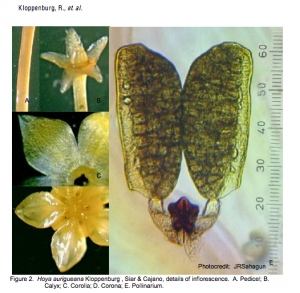
Robert Dale Kloppenburg, Maria Luisa D. Guevarra, Jennelyn M. Carandang, and Faith S. Maranan reported the discovery of six new species of Hoya R. Br. (Apocynaceae, Asclepiadoiceae) that are indigenous to the Philippines. The six new species are as follows: Hoya aurigueana Kloppenburg, Siar & Cajano 2012, Hoya benstoneana Kloppenburg, Siar, Guevarra & Carandang 2012, Hoya bicolensis Kloppenburg, Siar & Cajano 2012, Hoya persicina Kloppenburg, Siar, Guevarra, Carandang & Mendoza 2012, Hoya valmayoriana Kloppenburg, Guevarra & Carandang 2012, and Hoya vicencioana Kloppenburg, Siar, Cajano, Guevarra & Carandang 2012. These species bring the number of known Philippine Hoya species to more than 80. The discovery happened after a country-wide germplasm collection activity of the Crop Science Cluster-Institute of Plant Breeding on indigenous ornamental plants including Hoya. The activity was accomplished through collection trips, collaboration with plant collectors, and exchanges with Hoya growers and enthusiasts from different parts of the country.
According to the authors, there is a need to conserve these species in cultivation given the continuous degradation of their natural habitats and unpredictable climatic conditions. They recommended the promotion and dissemination of the importance of these species to the public as a strategy of conserving them. The Hoya species are being maintained and propagated at the Fruit and Ornamental Crops Section, Institute of Plant Breeding, Crop Science Cluster, UP Los Baños. These will be available starting 3rd quarter of 2013 to any interested individuals or groups.
The full report is published in the Journal of Nature Studies, the official peer-reviewed journal publication of the Society. Other articles published in the journal include “Knowledge, Attitudes, and Practices Towards Toxic and Hazardous Substances: The Case of Selected Communities in Bulacan, Philippines” by Mendoza, M. E.T., Visco, E.S., Jimena, C.E.G., Amparo, J.S., and Mendoza, M.D.; “Orders and Families of Philippine Pteridophytes” by Marjorie Dida-Agun delos Angeles and Inocencio E. Buot Jr.; “Utilization of Agricultural Waste and Biological Agents to Increase Rice Yield“ by Oktavia S. Padmini and R.R. Rukmowati Brotodjojo; “Audio-Visuality in Nature Studies: The Use of Video in Nature Research and Education” by Primo G. Garcia and Grace J. Alfonso; “The Promises of Chlorella vulgaris as the Best Alternative for Biodiesel: A Review” by Lea C. Garcia; “The Changing Climate and Its Implications to Capture Fisheries: A Review” by K.H.M. Ashoka Deepananda and Edison D. Macusi; “Anti-inflammatory activities of the aqueous extract of the stem of Tinospora crispa” by Regina Lourdes B.Hipol, Maria Faye Nenette M. Cariaga, and Roland M. Hipol; and “Pollen contents of Apis mellifera Linn. honey from Davao City, Philippines” by Rodelina A. Cunanan-Deyto, Analinda C. Manila-Fajardo and Cleofas R. Cervancia.
These articles can be downloaded from the journal. The journal can be accessed by clicking on this link: https://sites.google.com/a/pssnonline.org/journal-of-nature-studies/volume-11-numbers-1-2-january-december-2012 or through the link at the menu section of this page.

Leave a Reply